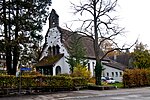Museum of Communication Bern
Museums in BernPhilatelic museumsPostal museums

The Museum of Communication is an interactive museum dedicated to the subject of communication in Bern, Switzerland. In 2019 it was awarded the Council of Europe Museum Prize. It was founded in 1907 as the corporate museum of Swiss Post (later called PTT), the national postal service of Switzerland. The restructuring of the museum into a foundation of Swiss Post and Swisscom led to a broadening of the overall theme and a new name, the Museum of Communication. The latest incarnation of the museum, which opened its doors with a redesigned permanent exhibition in 2017, is focused completely on its visitors.
Excerpt from the Wikipedia article Museum of Communication Bern (License: CC BY-SA 3.0, Authors, Images).Museum of Communication Bern
Helvetiastrasse, Bern
Geographical coordinates (GPS) Address Website External links Nearby Places Show on map
Geographical coordinates (GPS)
| Latitude | Longitude |
|---|---|
| N 46.9418 ° | E 7.45 ° |
Address
Museum für Kommunikation
Helvetiastrasse 16
3005 Bern (Stadtteil IV)
Bern, Switzerland
Open on Google Maps










